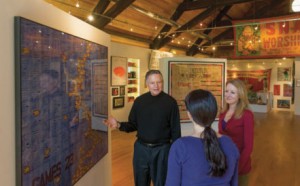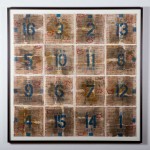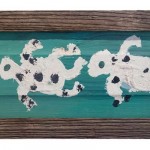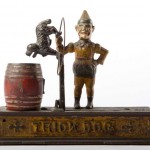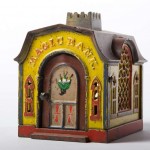Victor Keen ’63 and his Collection of Outsider Art
by Jim H. Smith
William “Bill” Traylor was born into slavery on an Alabama plantation on April 1, 1854. After the Civil War, he continued to live on and farm the plantation for most of his life. Only when he was 75, in 1939, did he give up the farm for city life, moving to Montgomery, where he worked day jobs and bunked in back rooms at a funeral parlor and a cobbler’s shop.
Whenever he wasn’t working, he could be found sitting on the sidewalk and drawing. His output would have been protean for any artist. But for a septuagenarian with no formal training in art, the estimated 1,200 to 1,500 drawings he produced during that brief span of time were astounding. They chronicled Montgomery street life and Traylor’s years on the plantation.
He sold his drawings for nominal amounts, relying on the largesse of others to survive. After a brief stay with some of his children in the North, he returned to Montgomery, where he passed away in 1949. Martin Ramirez, born in Mexico in 1895, left his wife and children behind in 1925 and embarked upon a fateful journey to California in search of work. In Woody Guthrie’s “Garden of Eden,” he found mostly rejection. Six years later, destitute and unable to communicate, he was pulled out of the gutter by police and committed to a state hospital in California, where he was diagnosed as a catatonic schizophrenic.
Ramirez spent the next 32 years, the remainder of his life, confined to a mental institution. Though he, like Traylor, had no formal training, he mastered a personal artistic style that combined various media to produce highly detailed depictions of landscapes incorporating both prosaic and mystical imagery. Before his death he produced some 300 major works.
Traylor and Ramirez, who never met each other, are two of the leading figures in a genre generally referred to as “outsider” art. It is characteristic of such artists that they were untrained in art and operated outside the artistic mainstream; indeed, often outside the mainstream of society.
Most were hobbled by significant impediments, such as some form of mental illness. Yet they found ways to express themselves vividly through a remarkable array of media. And their works, which have survived against equally daunting odds, are highly sought by collectors and command prices the artists could never have imagined. Outsider art now resides in major private collections and museums throughout the world, and has recently received added prominence with the opening of a major exhibit at the Philadelphia
Museum of Art that was favorably reviewed by The Wall Street Journal and The New York Times.
Eye-opening experiences
“It’s the personal narratives of these artists coupled with the compelling nature of the art that appealed to me,” says Victor F. Keen ’63, who began collecting outsider art about 15 years ago and now owns more than 150 pieces, one of the world’s largest private collections. The son of a social worker and a lawyer with a private practice, Keen grew up in Pueblo, Colorado. Before enrolling in Trinity, he had never been farther east than the high plains of western Kansas, where he had a summer job on farm.
Though he’d had ample exposure to the legal profession by observing and talking with his father, he arrived in Hartford with no particular inclination to pursue a career in that field.
Rather, he says, his Trinity education was the kind of broadening experience one
expects from a great liberal arts college.
“I took classes in economics, history, and English, and was impressed by the extraordinary quality of Trinity professors like George Cooper, Norton Downs, E. Finlay Whittlesey, Larry Towle, and a mentor, Dick Scheuch,” Keen recalls. “I got a terrific education that expanded the view of the world I brought from Pueblo. I considered various post-college alternatives, but I suppose law was always in the back of my mind.”
After earning his J.D. at Harvard Law School in 1966 and serving a clerkship at the United States Tax Court in Washington, D.C., he practiced tax law in New York City for 25 years before moving to Philadelphia. From 1994 until 2008 he headed the tax practice group at Duane Morris LLP, a Philadelphia-based, 600-attorney law firm with an international presence. He then became “of counsel” to the firm, substantially reducing time devoted to the practice of law.
Since his “retirement” he has increased his involvement in other activities that he had been pursuing over the years. He is currently on the boards of two high-tech public companies and owns and manages a real estate portfolio (with Jim Tozer ’63) in the Meatpacking District of Manhattan. He also serves on the boards of the Philadelphia Theater Company and PlayPenn, a national service organization supporting new plays and playwrights.
“While my primary involvement with theater at Trinity was nurtured by a favorite professor, George E. Nichols III, I developed a more serious interest in theater shortly after graduation as a result of my introduction to and active engagement with the Trinity La MaMa program in New York, led by its highly talented founders, Leo Shapiro and Judy Dworin,” Keen says.
Becoming a collector
Keen’s interest in and knowledge of “outsider” art began with his 35-year friendship with Frank Maresca, co-founder of Ricco Maresca, a prominent art dealer in New York. But his collecting has not been limited to outsider art.
At a flea market back in the 1970s, he spotted a radio manufactured by the Catalin Corporation of America. In the 1930s the company had begun producing radios with cabinets molded from a phenol-formaldehyde compound called catalin. Exemplars of art deco, they are now valued for their sleek style. That radio at the flea market initiated Keen’s collection, which now numbers over 70 radios, most of which originally sold for $25 to $50 but are now valued at between $4,000 and $20,000 apiece.
While working in New York, Keen met his future wife, Jeanne Ruddy, former principal dancer with the Martha Graham Dance Company and member of the dance faculty at The Juilliard School. Following their move to Philadelphia, Jeanne started a contemporary dance company, Jeanne Ruddy Dance. In order to provide a home and rehearsal space for the company, they acquired a 100-year-old former horse stable and converted it into “The Performance Garage,” which was utilized for 12 years by Jeanne Ruddy Dance and over 100 other small and emerging Philadelphia dance companies.
As his collections grew, Keen recognized that a permanent site was necessary to appropriately manage and display them. The property adjacent to the Performance Garage, also then owned by Victor and Jeanne, had a rich and compelling history. It was the former Bethany Mission for Colored People, a Quaker meeting house built in 1869, which for over 70 years provided literacy training and religious education for local African-American children.
Keen undertook a complete restoration of the building, a task that was completed in 2012. The space now serves not only as a place for displaying his collections, but also as a private meeting space, available for special events for charitable and other worthwhile organizations.
Celebrating the 50th anniversary of his graduation from Trinity, Keen has bequeathed the entire collection of “outsider” art and Catalin radios, valued in excess of $1.5 million, to his alma mater. “Trinity gave me not only a great undergraduate education, but a terrific group of lifelong friends,” says Keen, who is proud of having played a role in organizing the ’63 Class Homecoming reunions, which have been held continuously for over 30 years, and creating and maintaining the unique Class of ’63 Scholarship Program. “My connection with the College has been strong since graduation,” he says. “Trinity has been immensely meaningful for me, and I feel fortunate that I am in a position to give a little back for all the value and enjoyment I’ve received, and continue to receive, from my Trinity experience.”
- Woman on Horse Martin Ramirez (1895-1963)
- Wooster Vinal’s 1908 Sail-Cart Francois Deschamps (1946- )
- Magic Square 34 George Widener (1953- )
- Antique Cast Iron “Vault” Bank ca. 1880
- Turtles Clyde Jones (1938- )
- Black Dog Bill Traylor (1854-1947)
- Antique Cast Iron “Trick Dog” Bank ca. 1888 Hubley
- The Pontificator Joyce Thornburg (1949- )
- Antique Cast Iron “Magic” Bank J. E. Stevens & Co. 1873
- Antique Cast Iron “Tammany” Bank Ca. 1873 J. & E. Stevens & Co.
- Miscellaneous Catalin Radios ca.1935-1945
- Untitled Mose Tolliver (1919-2006)
- Man Having Got His Hand to the Plow Howard Finster (1906-2001)
- Antique Cast Iron “Elephant” Bank ca. 1888 Hubley
- Black Cat Howard Finster (1906-2001)
- Devil Ham R. A. Miller (1912-2006)
For even more about Keen and his Bethany Mission Gallery, visit www.bethanymissiongallery.org.


